The MGA With An Attitude
In-Car AMP METER -- ET-221
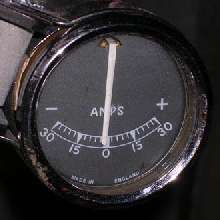 Here's hoping that you read the information about the volt meter first, as the volt meter may be a more useful instrument for a daily drive car. But if you insist on using an amp meter, here's the information.
Here's hoping that you read the information about the volt meter first, as the volt meter may be a more useful instrument for a daily drive car. But if you insist on using an amp meter, here's the information.
The most important feature of the amp meter is that it is a low resistance high current device. It must be installed in series with an electrical load to limit current flow. If you were to wire the amp meter directly across the battery (as you would with a volt meter) the amp meter would immediately pass so much current as to fry the meter, almost instantly. Some amp meters may actually be fused for internal protection. When properly wired in series with an electrical load the amp meter will monitor the current flowing in the circuit.
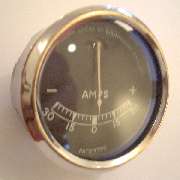
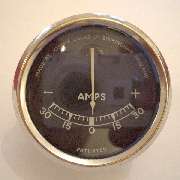
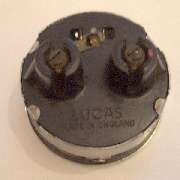
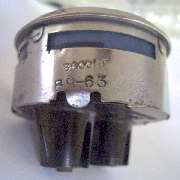 This particular ammeter appears to be 1963 manufacture, so not exactly the correct period for MGA. The chrome trim ring is bevelled on the OD, not matching the cylindrical OD on other MGA instrumets. However, since the ammeter was never standard equipment on the MGA, an aftermarket accessory could be almost any design (hopfully not ugly).
This particular ammeter appears to be 1963 manufacture, so not exactly the correct period for MGA. The chrome trim ring is bevelled on the OD, not matching the cylindrical OD on other MGA instrumets. However, since the ammeter was never standard equipment on the MGA, an aftermarket accessory could be almost any design (hopfully not ugly).
The most common dial range for an amp meter to be used in an MG with a generator would be -30 to +30 amps (with 0 in the center). If you want to use an amp meter with an alternator, it may need to show -60 to +60 amps, or possibly even higher, enough to handle the expected alternator output capacity. If you have 100 amp alternator you would need a 100 amp meter.
The direct reading vintage analog type dash mounted amp meter requires hookup wires sufficiently large to carry the full current in the circuit being monitored. A 30 amp meter would need a pair of 10 gauge wires. A 60 amp meter would need 8 gauge wires. A 100 amp meter would need 6 gauge wires. These wires have to run through the passenger compartment behind the dash to get to the meter. One of these wires will be a direct connection to the vehicle battery with almost unlimited current output capacity, and the wire will be unfused. If this wire should at any time for any reason incur a short circuit to chassis ground, the result would be something like burning off a welding rod with the only limit to current being the resistance of the wire (which is virtually zero ohms) and the internal resistance of the battery (which may be only a few milliohms). As such, this large unfused hookup wire represents a personal safety risk (fire or burn hazard), so you need to be very careful to protect the wire from damage, and proper bulkhead grommets are first order of the day.
A modern alternative amp meter may use smaller wiring and can be much safer. This is a shunt type amp meter. The shunt is a low resistance high current resistor, possibly a short metal bar of copper or iron or some resistor alloy, connected in series with the system electrical load you want to monitor. This shunt will exhibit a small voltage drop from end to end proportional to the current passing through it. If the resistance is very small it will not appreciably inhibit current flow and will have no affect on the electrical system in the vehicle. But with very small resistance it will also generate only a very small voltage differential across the shunt. To monitor this the meter needs to be a very low resistance galvanometer (volt meter for very low voltage).
A shunt with 0.001 ohm resistance will produce a 0.03 volt drop at 30 amps. Being a resistor it would also generate 0.9 watts of heat. The shunt then must be designed and installed to accommodate the dissipation of 0.9 watts of heat. The dash mounted gauge must be capable of full swing of the needle with only +0.03 to -0.03 volts to drive it. This would be a sensitive instrument (possibly delicate). A meter with higher voltage range could be used if a voltage amplifier was used at the shunt resistor, which is commonly what is done for a modern amp meter. This then requires a "sending unit" to be connected in series with the circuit to be monitored, and a separate gauge for the dash readout. The gauge then is really a volt meter with the face dial marked in amps.
There are a few different ways to use an amp meter. I will briefly describe the less common setups first.
If you want to monitor only the health and operation of the generator, the amp meter can be connected in series with the dynamo output wire. This will give you a regular reading of the dynamo output, but will tell you nothing else. If the vehicle electrical load is high (all lights and accessories on) or the battery is significantly discharged, the dynamo output will be high (perhaps 20 amps). If the battery is fully charged and the vehicle current demand is low (like ignition only) then the dynamo output will be similarly low. The dynamo current should never be negative with this setup, so the gauge in this case may be configured to read 0 to 30 amps. But this setup will never tell you anything about the condition or state of charge of the battery.
If you want to monitor only the total electrical load of the vehicle (not the charging function), then you wire the amp meter in series with the wire running from the control box to the ignition switch. This will monitor all power draw except for the horn, and will exclude the generator output. While this can tell you how much electrical power the car is consuming, it will tell you nothing about the state of the battery or the generator.
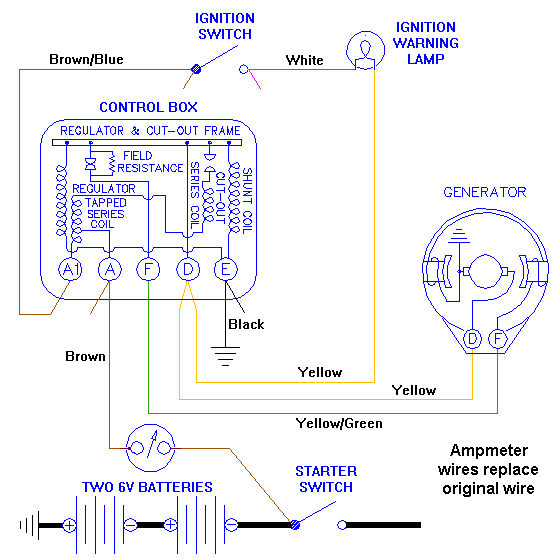
Being more sensible now we get to the normal installation. The amp meter should be wired in series with the fat brown wire running from the starter switch to the control box (either end will do). This will monitor the net current flow in and out of the battery, including total power consumption (including the horn) and the dynamo output, but will exclude the ultra high current circuit which drives the starting motor. Cranking the engine (perhaps 200 amps) will show no effect on the amp meter. Blowing the horn may momentarily peg the amp meter on the negative side, but a short momentary surge of 30 to 50 amps will not harm the meter. If you switch on all lights and accessories with the engine off you will see a large discharge, perhaps -20 amps. If you switch off lights and accessories and start the engine, you should see some positive charging of the battery. If the battery might be largely discharged, and the engine runs with only the ignition switched on, then revving up to 2500 RPM may produce full output of the dynamo, giving 4 amps to the ignition coil and the other 18 amps to the battery for charging (which would show as +18 on the amp meter).
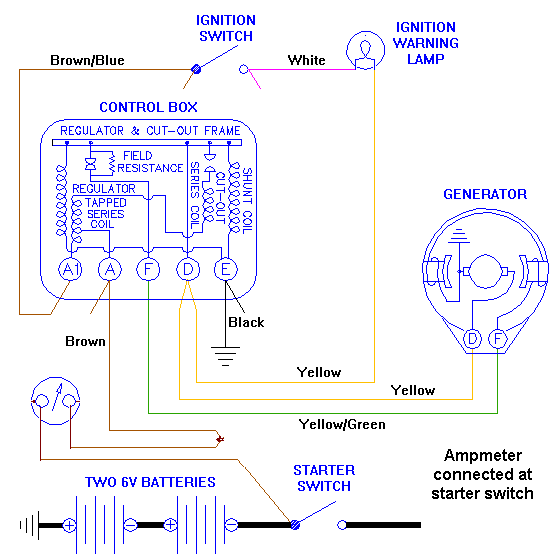
So with this setup the meter might at times read from +18 to -20, and it may momentarily peg past -30 if you blow the horn. But keep in mind that the amp meter is monitoring net current in or out of the battery. For most normal operating conditions when the battery is near full charge with engine running, the control box will regulate dynamo output to satisfy the vehicle load demand, and the net current flow to the battery will be quite small. Most of the time the amp meter will be reading in the 0 to +3 amp range at road speed or maybe in the 0 to -5 amp range at idle speed. If you have a sharp eye you may be able to tell if it is charging or discharging a little, but that's about all. This will tell you nothing about the health or state of charge of the battery. If the system stops charging completely the amp meter might show substantial discharge, but the ignition light would also come on to tell you the dynamo quit working, so the amp meter is adding very little to help the situation.
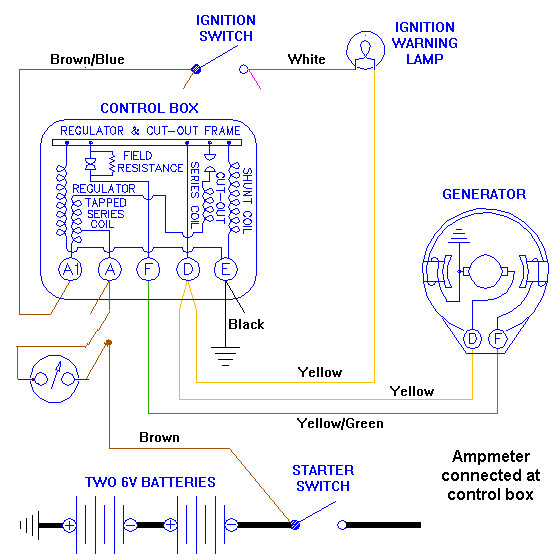
It will also tell you precious little about the health or state of adjustment of the control box. One potential problem is what happens if the control box might drift a bit out of adjustment, and the dynamo output is a little low (a fairly common problem). Here it may be charging a little, but not much. The amp meter may show +1 to +3 amps during the day when the headlights are off, and maybe everything seems okay. But if you shut the engine off and restart a few times (heavy momentary current draw), or you have extended periods of engine idling (small negative current flow for prolonged periods), then the battery may become unexpectedly discharged without noticing. This is more serious when you switch on the headlights at night, and you may not notice the amp meter going negative. With some significant discharge it doesn't take long for the battery to go low, the lights to get dim, and the engine may not re-start after a pit stop. For the amp meter to do you any good in this circumstance you have to watch it like a hawk, especially when the lights and accessories are on, and you have to understand what the meter is trying to tell you.
Bottom line here, for the case of a failing charging system or discharged battery a volt meter will be much more useful than the amp meter. The volt meter can tell you so much more than the fact that the battery is discharging. Perhaps most important, the volt meter may give you an idea of how much longer you may be able to drive before the battery voltage gets so low that ignition goes dead.
If you want to install an ammeter, hook it up like one of the diagrams show. It's easy to tell if you have the the wires correct on the ammeter. Blow the horn and watch the needle jump. If it jumps to the negative side you have it right. If it jumps positive you need to switch the wires on the ammeter to make it go negative with horn blow.
This is not necessarily indicating direction of current flow in the wire, as positive or negative earth make the current flow in opposite directions. The ammeter will be indicating net charge or discharge of the battery.
|